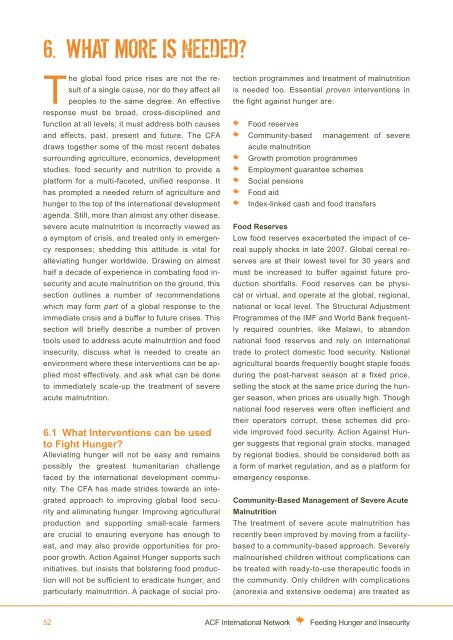Feeding hunger and insecurity
Feeding hunger and insecurity
Feeding hunger and insecurity
- No tags were found...
You also want an ePaper? Increase the reach of your titles
YUMPU automatically turns print PDFs into web optimized ePapers that Google loves.
6. What More is Needed?The global food price rises are not the resultof a single cause, nor do they affect allpeoples to the same degree. An effectiveresponse must be broad, cross-disciplined <strong>and</strong>function at all levels; it must address both causes<strong>and</strong> effects, past, present <strong>and</strong> future. The CFAdraws together some of the most recent debatessurrounding agriculture, economics, developmentstudies, food security <strong>and</strong> nutrition to provide aplatform for a multi-faceted, unified response. Ithas prompted a needed return of agriculture <strong>and</strong><strong>hunger</strong> to the top of the international developmentagenda. Still, more than almost any other disease,severe acute malnutrition is incorrectly viewed asa symptom of crisis, <strong>and</strong> treated only in emergencyresponses; shedding this attitude is vital foralleviating <strong>hunger</strong> worldwide. Drawing on almosthalf a decade of experience in combating food <strong>insecurity</strong><strong>and</strong> acute malnutrition on the ground, thissection outlines a number of recommendationswhich may form part of a global response to theimmediate crisis <strong>and</strong> a buffer to future crises. Thissection will briefly describe a number of proventools used to address acute malnutrition <strong>and</strong> food<strong>insecurity</strong>, discuss what is needed to create anenvironment where these interventions can be appliedmost effectively, <strong>and</strong> ask what can be doneto immediately scale-up the treatment of severeacute malnutrition.6.1 What Interventions can be usedto Fight Hunger?Alleviating <strong>hunger</strong> will not be easy <strong>and</strong> remainspossibly the greatest humanitarian challengefaced by the international development community.The CFA has made strides towards an integratedapproach to improving global food security<strong>and</strong> eliminating <strong>hunger</strong>. Improving agriculturalproduction <strong>and</strong> supporting small-scale farmersare crucial to ensuring everyone has enough toeat, <strong>and</strong> may also provide opportunities for propoorgrowth. Action Against Hunger supports suchinitiatives, but insists that bolstering food productionwill not be sufficient to eradicate <strong>hunger</strong>, <strong>and</strong>particularly malnutrition. A package of social protectionprogrammes <strong>and</strong> treatment of malnutritionis needed too. Essential proven interventions inthe fight against <strong>hunger</strong> are:Food reservesCommunity-based management of severeacute malnutritionGrowth promotion programmesEmployment guarantee schemesSocial pensionsFood aidIndex-linked cash <strong>and</strong> food transfersFood ReservesLow food reserves exacerbated the impact of cerealsupply shocks in late 2007. Global cereal reservesare at their lowest level for 30 years <strong>and</strong>must be increased to buffer against future productionshortfalls. Food reserves can be physicalor virtual, <strong>and</strong> operate at the global, regional,national or local level. The Structural AdjustmentProgrammes of the IMF <strong>and</strong> World Bank frequentlyrequired countries, like Malawi, to ab<strong>and</strong>onnational food reserves <strong>and</strong> rely on internationaltrade to protect domestic food security. Nationalagricultural boards frequently bought staple foodsduring the post-harvest season at a fixed price,selling the stock at the same price during the <strong>hunger</strong>season, when prices are usually high. Thoughnational food reserves were often inefficient <strong>and</strong>their operators corrupt, these schemes did provideimproved food security. Action Against Hungersuggests that regional grain stocks, managedby regional bodies, should be considered both asa form of market regulation, <strong>and</strong> as a platform foremergency response.Community-Based Management of Severe AcuteMalnutritionThe treatment of severe acute malnutrition hasrecently been improved by moving from a facilitybasedto a community-based approach. Severelymalnourished children without complications canbe treated with ready-to-use therapeutic foods inthe community. Only children with complications(anorexia <strong>and</strong> extensive oedema) are treated as52ACF International Network<strong>Feeding</strong> Hunger <strong>and</strong> Insecurity

















